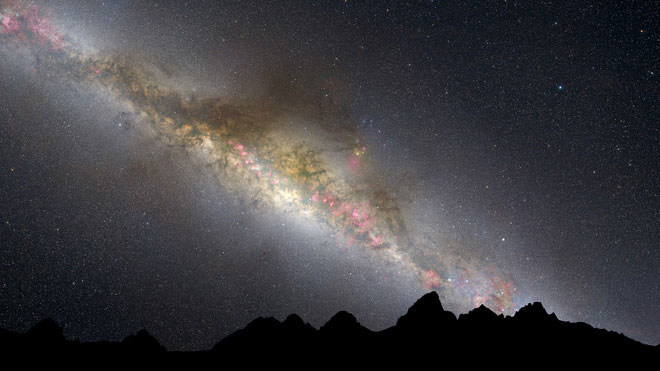Most of the extraterrestrial civilizations that once dispersed around our Milky Way probably perished on their own. This is the result of a recently published study, after researchers mapped the emergence and disappearance of extraterrestrial civilizations billions of years since our galaxy was formed.
Accordingly, this result can be considered as the latest update of the “Drake Equation”, which is used to estimate the number of extraterrestrial civilizations in the Milky Way.
 A series of civilizations may have formed in the Milky Way billions of years ago, but perished on their own for various reasons.
A series of civilizations may have formed in the Milky Way billions of years ago, but perished on their own for various reasons.
Created by astronomer Frank Drake in 1961, this famous equation relies on seven variables to calculate the number of civilizations in a galaxy that humans can communicate with, as the average ratio. an army of stars is formed in the galaxy every year; the likelihood that a civilization has developed such technology that its signs can be perceived in space and the length of time that such a civilization sends signals into space, etc.
However, the study just done by physicists at the California Institute of Technology is much more realistic than Drake’s equation. This study shows where and when life is likely to occur in the Milky Way. At the same time, it also helps to identify the most important factor: the tendency towards self-destruction of extraterrestrial civilizations.
“From the Hubble Space Telescope and the Kepler Space Telescope, we have a lot of knowledge about the gas and star densities in the Milky Way, the rate of star formation, and the rate of exogenous formation. planet … or the incidence of supernovae, ”said Jonathan H. Jiang, astrophysicist at NASA’s Jet Propulsion Laboratory, co-author of the study.
Extraterrestrial civilizations can be concentrated around 13,000 light years from the galactic center due to the prevalence of Sun-like stars here.
As a result, the researchers looked at a variety of factors believed to influence the development of a civilization, such as the prevalence of Sun-like stars containing Earth-like planets. Earth; The frequency of supernova explosions emitting deadly radiation; The probability and the time it takes for civilizations to flourish if the conditions are right.
Based on these factors, scientists modeled the evolution of the Milky Way galaxy in time and space. As a result, they found that the probability of life appeared to peak at a distance of 13,000 light years from the center of the galaxy, and about 8 billion years after the formation of the Milky Way.
For comparison, Earth is approximately 25,000 light-years from the galactic center, and human civilization arose approximately 13.5 billion years after the formation of the Milky Way, although simple life forms have it. made. appeared just after the planet was formed.
In other words, we could be a “frontier civilization” in terms of galactic geography. In addition, our civilization is also “born late” compared to other civilizations, which may have formed a long time ago.
 The probability of the appearance of life peaked at a distance of 13,000 light years from the galactic center, and about 8 billion years after the formation of the Milky Way.
The probability of the appearance of life peaked at a distance of 13,000 light years from the galactic center, and about 8 billion years after the formation of the Milky Way.
Of course, assuming life “resurfaces” across the galaxy, there are likely plenty of other civilizations out there that we haven’t discovered yet. These civilizations may be concentrated around 13,000 light years from the galactic center due to the prevalence of Sun-like stars here.
According to the researchers, most of the civilizations that still exist in the galaxy today are probably still relatively “immature.” Usually, it takes a long time for a civilization to be born, develop and perish for some reason. Of course, this also means that civilizations formed in the “golden” era over 5 billion years ago risk perishing on their own for a long time.
In fact, it is also an important “variable” in the model of researchers at the California Institute of Technology, based on the question: what causes civilizations in the galaxy often perish?
Accordingly, if we apply factors such as nuclear war or climate change to the model, it is highly likely that most of the civilizations that formed before us cannot exist to this day.


